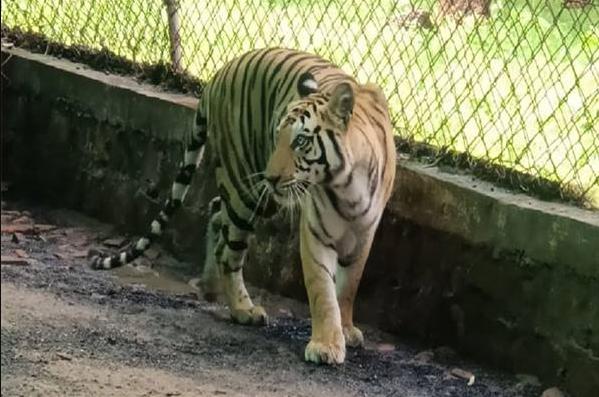It’s a tragic story of a beautiful breeding tigress. Four years ago, the tigress was sent from Bandhavgarh national park in Madhya Pradesh (MP) to Satkosia tiger reserve in Odisha along with a male tiger to revive the population of big cats. But apparent mishandling of the first ever interstate tiger relocation programme ended up in poaching of the male tiger named Mahaveer. Sundari, the tigress, landed up in a cage in Odisha where she languished for three years. While she was being shifted from one enclosure to another, the governments of MP and Odisha were engaged in bureaucratic procedures and passing the buck. Sundari, now about 8 year of age, is condemned to a smaller enclosure of 10000 sq feet in Van Vihar , an open zoo and rescue centre in the state capital of MP where she would spend the rest of her life. It is believed that the inter-state project was launched without proper preparations. The officials in Odisha also did not ascertain the reasons for declining tiger population in Satkosia.
One Cage To Other
Though the Satkosia fiasco has raised many questions , the Union ministry environment , forest and climate change, the two state governments, National Tiger Conservation Authority (NTCA) ,the apex body for tiger conservation, have maintained a deafening silence . Sundari reached Bhopal on July 14 after a 12 -hour torturing journey by road from Kanha national park to Van Vihar. Spending a 21- day quarantine period, the tigress spent a long time sitting silently in a small cage as if wondering over the red tapism prevailing in the governments. Over 3 year of age when she was sent to Odisha, Sundari was a ferocious wild tigress in Bandhavgarh national park. Now she is imprisoned for life in Van Vihar. After dilly dallying, MP responded reluctantly and she was sent to Kanha national park in March 2021. She undertook a painful journey of 612 km by road.
Must Read: Jailed in Jungle: Why Wild Tigress Languishes in Enclosure, Needs to Be Probed
She was housed in a Ghorela enclosure in the Mukki range of the park for 15 months in an attempt to rewild her. “Her hunting skills are perfect. During her stay in Ghorela enclosure for rewilding, Sundari preyed on several deer. The problem, however, was the human imprinting and conditional behaviour she developed during her stay in Satkosia enclosure. As the animal still possesses this behaviour, it was not advisable to release her to wild conditions”, officials in Kanha said. She developed a tendency of moving close to humans because of long stay in enclosures in Odisha.” Had we released her in the wild she could have ventured in villages or gone closer to the field staff of the park”, they said. The tigress had allegedly killed two people in Odisha before she was first sent to an enclosure in 2018.
Was Sundari In Enclosure Before Sent to Odisha ?
Also read: Tiger Takes Rest After Months Of Tourism Stress
The male tiger, however, was found dead - caught in a poacher's snare - in Satkosia on November 14, 2018, while Sundari was tranquillised and brought back to the holding area in Raigoda after it allegedly attacked local villagers who had ventured into the forest leading to a law and order situation. The National Tiger Conservation Authority (NTCA) in December 2019 suspended the tiger relocation project indefinitely and ordered restoration of the tigress to MP. As the MP Government expressed its 'reluctance' in shifting the tigress, a petition was filed in Madhya Pradesh High Court and in November 2020, the court directed that she be brought back to MP and trained for rewilding. But that too failed and Sundari was sent to Van Vihar.




Comments
Post a Comment